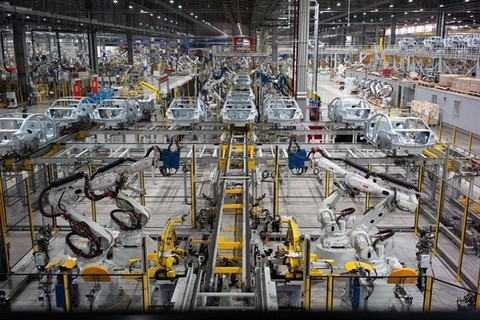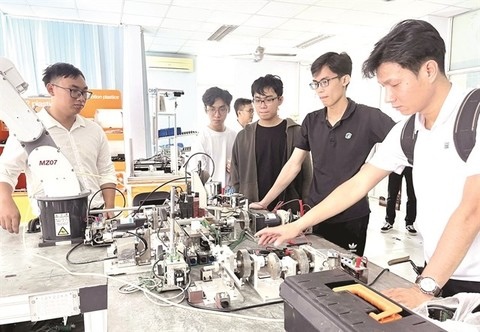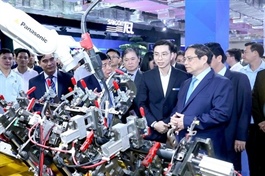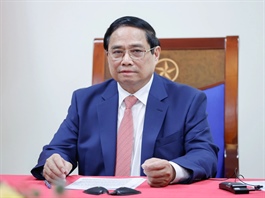Harnessing AI for Việt Nam’s economic future
Harnessing AI for Việt Nam’s economic future
In the dynamic landscape of Southeast Asia, Việt Nam is poised on the brink of a technological revolution, aiming to leverage the power of AI to redefine its economy, foster innovation, boost productivity and enhance global competitiveness.

Modern vehicle production at VinFast in Hải Phòng City. AI is expected to boost Việt Nam's manufacturing competitiveness, advance the EV industry, and help meet green energy goals. — VNA/VNS Photo |
In its July 2024 report, "An AI Opportunity Agenda for Việt Nam", Google emphasised the critical role of digitalisation and AI in transforming Việt Nam’s economy, making it more diversified and competitive on regional and global scales.
The report estimates that AI could generate up to US$835 billion in economic benefits across six Southeast Asian economies, including Việt Nam, by 2030. To achieve the goal of having the digital economy contribute 30 per cent of GDP by 2030 — up from 12 per cent in 2023 — Việt Nam must attract significant investment and drive AI innovation.
New driver of economic growth
Google's research highlights that AI will play a crucial role in Việt Nam's digital economy, potentially generating an annual economic impact of VNĐ1.73 quadrillion (US$74 billion) by 2030. The study, covering 43 sectors, found that more than half could achieve breakthroughs through AI.
AI is expected to bolster Việt Nam's manufacturing competitiveness, advance the electric vehicle (EV) industry, and help meet green energy goals. It will also enhance agricultural efficiency, address climate challenges, and support economic growth.
Moreover, AI is vital for Việt Nam’s ambition to become a high-income developed country by 2045, driving productivity, attracting investment, creating high-tech jobs, and supporting micro, small, and medium enterprises (MSMEs), according to the report.
Despite the critical role of productivity growth in economic development, Việt Nam has missed its labour productivity targets for three consecutive years, with the 2024 goal set lower than in 2023.
The "Việt Nam’s Future Digital Economy towards 2030 and 2045” report estimates that the digital economy could contribute 7-16.5 per cent annually to productivity growth from 2020 to 2030. Although this impact is initially modest, AI could significantly boost productivity, potentially doubling GDP contributions compared to new business models, according to McKinsey.
“This isn't merely about typical development; it's about breakthrough growth. Advancing AI applications will also catalyse the growth of tech startups in Việt Nam,” said Đỗ Tiến Thịnh, deputy director of the National Innovation Centre (NIC), in an interview with Việt Nam News.
Việt Nam is already harnessing AI to enhance its competitiveness as a manufacturing hub, particularly in high-tech industries like electronics and telecommunications. Leading Vietnamese enterprises such as Viettel, FPT, VinAI, CMC, and VNPT are at the forefront of AI innovation, demonstrating the technology’s potential to benefit a wide range of businesses.

FPT imported Việt Nam's first Nvidia's DGX H100 servers. Leading Vietnamese enterprises such as Viettel, FPT, Vingroup, CMC and VNPT are at the forefront of AI innovation. — Photo courtesy of FPT |
Investment in AI is also rising, with over $4.6 billion invested in Vietnamese startups from 2014 to 2023, according to the 2024 Việt Nam Technology and Innovation Investment Report by NIC and Do Ventures. This reflects Việt Nam's burgeoning status as a centre for technological innovation.
Strategic advantages
Oxford Insights, in its early 2024 report, ranked Việt Nam 59th out of 193 countries and territories for government AI readiness, and 5th in the ASEAN region. The report highlighted Việt Nam’s vibrant economy, youthful and tech-savvy population, burgeoning tech sector, and influx of international investment as fertile grounds for AI innovation.
Research by Thundermark Capital also listed Việt Nam and Singapore as the two Southeast Asian representatives in the global Top 30 for AI research.
Việt Nam's strategic position in AI development is supported by several key advantages.
The country’s burgeoning digital economy, aimed at contributing 20 per cent of GDP by 2025 and 30 per cent by 2030, provides a strong foundation for AI integration. The rapid growth of Việt Nam’s internet economy, already among the fastest-growing in the world, further strengthens its position.
Việt Nam’s young, tech-savvy population is also a significant asset. The country has a large pool of engineers and IT professionals, many well-versed in AI technologies. This, combined with a strong emphasis on STEM education, ensures a steady pipeline of talent to drive AI innovation.
Many major international companies see Việt Nam as a promising research and development hub. Recent visits and large-scale conferences featuring foreign tech leaders like Nvidia chairman Jensen Huang and Google AI lead Jeff Dean have underscored Việt Nam's potential in this field.
The government's strong commitment to AI development is another critical factor. The National Strategy on R&D and Application of AI until 2030, issued in March 2021, aims to position the country as a leading hub for AI innovation in Southeast Asia and globally by 2030.
Nguyễn Thị Bích Ngọc, deputy minister of Planning and Investment, said that the government had implemented policies to foster AI research and development. The ministry is proposing a project to develop 5,000 AI experts for the semiconductor industry by 2030. Additionally, the National Innovation Centre is tasked with establishing an AI training and research centre to train 7,000 AI experts and incubate around 500 AI startups by 2030.
Navigating challenges
Despite its promising prospects, Việt Nam faces several challenges in advancing its AI sector.
One of the primary obstacles is the shortage of skilled professionals. According to FPT Digital’s DxReport Việt Nam has nearly 400,000 engineers specialising in IT, and more than 50,000 IT students graduating each year. However, this talent pool serves just 25 per cent of Việt Nam’s total demand for IT workers.

Students at Saigon Hi-Tech Park. The government is investing in educational programmes and training initiatives designed to cultivate a workforce capable of driving AI innovation. — VNA/VNS Photo |
To address this, the government is investing in educational programmes and training initiatives designed to cultivate a workforce capable of driving AI innovation. Partnerships with international tech firms and academic institutions are also crucial in bridging the skills gap.
NIC’s Deputy Director Đỗ Tiến Thịnh said the centre was developing projects to enhance the IT workforce through short- and long-term training programmes that meet international standards and align with business needs. For instance, Google’s incubation programme would support 20 AI-driven companies with up to $350,000 each and provide AI training for 200 businesses, alongside offering 40,000 scholarships for basic AI courses on Coursera.
Meta is also supporting the AI ecosystem in Việt Nam by collaborating with the government, participating in the AI4VN event, and hosting Vietnamese students at the Silicon Valley International Inventions Festival. Additionally, Meta will support the Vietnam Innovation Challenge 2024 with expertise and resources for AI and semiconductor sectors.
“We believe that open innovation in AI leads to better, safer products, faster innovation, and a larger and more diverse overall market. Meta is providing resources, expertise, and opportunities to develop innovative AI solutions. We will continue to work with the Government of Việt Nam, local businesses and the tech industry to support the country's vibrant AI ecosystem," Dr Rafael Frankel, director of Public Policy, Southeast Asia at Meta, told Việt Nam News.
Another senior NIC expert, Nguyễn Thị Ngọc Dung, emphasised the need for significant investment in infrastructure to support AI development. She said that businesses, especially SMEs, needed advanced resources like supercomputers and cloud services. While eager to explore AI opportunities, these businesses required government support in the form of policy frameworks and resource connections.
The AI revolution presents Việt Nam with a unique opportunity to drive economic growth and emerge as a technological leader. By tackling existing challenges and leveraging its strengths, the country can secure a prominent role in the global AI landscape, fostering a future of innovation and sustainable development.























